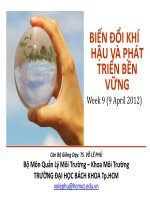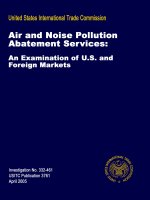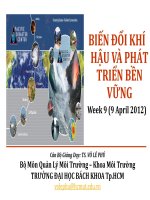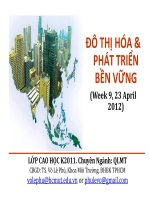Week 9 Entering Foreign Markets 2.Docx
Bạn đang xem bản rút gọn của tài liệu. Xem và tải ngay bản đầy đủ của tài liệu tại đây (196.92 KB, 48 trang )
Week 9 – Entering Foreign
Markets 2
Starbucks' Foreign Entry
Strategy
Forty years ago, Starbucks
was a single store in Seattle's
Pike Place Market selling
premium-roasted coffee.
Today, it is a global roaster
and retailer of coffee with
some 24,464 stores, 47
percent of which are in 63
countries outside the United
States. China (2,204 stores),
Canada (1,418 stores), Japan
(1,160 stores), South
Korea (872 stores), and the
United Kingdom (898 stores)
are large markets
internationally for Starbucks.
Starbucks set out on its
current course in the 1980s
when the company's director
of marketing, Howard
Schultz, came back from a
trip to Italy enchanted with
the Italian coffeehouse
experience. Schultz, who
later
became CEO, persuaded
the company's owners to
experiment with the
coffeehouse format—and
the
Starbucks experience was
born. The strategy was to sell
the company's own premium
roasted coffee and
freshly brewed espresso-style
coffee beverages, along with
a variety of pastries, coffee
accessories, teas,
and other products, in a
tastefully designed
coffeehouse setting. From
the outset, the company
focused on
selling "a third-place
experience," rather than just
the coffee. The formula led to
spectacular success in the
United States, where
Starbucks went from
obscurity to one of the best-
known brands in the country
in a
decade. Thanks to Starbucks,
coffee stores became places
for relaxation, chatting with
friends, reading the
newspaper, holding business
meetings, or (more recently)
browsing the web.
In 1995, with 700 stores
across the United States,
Starbucks began exploring
foreign market opportunities.
The first target market was
Japan. The company
established a joint venture
with a local retailer, Sazaby
Inc.
Each company held a 50
percent stake in the venture,
Starbucks Coffee of Japan.
Starbucks initially invested
$10 million in this venture, its
first foreign direct
investment. The Starbucks
format was then licensed to
the
venture, which was charged
with taking over
responsibility for growing
Starbucks' presence in Japan.
To make sure the Japanese
operations replicated the
"Starbucks experience" in
North America, Starbucks
transferred some employees
to the Japanese operation.
The licensing agreement
required all Japanese store
managers and employees to
attend training classes
similar to those given to U.S.
employees. The agreement
also required that stores
adhere to the design
parameters established in
the United States. In 2001,
the
company introduced a stock
option plan for all Japanese
employees, making it the first
company in Japan to
do so. Skeptics doubted that
Starbucks would be able to
replicate its North American
success overseas, but
now in 2018 Starbucks has
1,160 stores and a profitable
business in Japan.
After Japan, the company
embarked on an aggressive
foreign investment program.
In 1998, it purchased
Seattle Coffee, a British
coffee chain with 60 retail
stores, for $84 million. An
American couple, originally
from Seattle, had started
Seattle Coffee with the
intention of establishing a
Starbucks-like chain in
Britain.
In the late 1990s,
Starbucks opened stores in
Taiwan, Singapore,
Thailand, New Zealand,
South Korea,
Malaysia, and—most
significantly—China. In Asia,
Starbucks' most common
strategy was to license its
format to a local operator in
return for initial licensing fees
and royalties on store
revenues. As in Japan,
Starbucks insisted on an
intensive employee-training
program and strict
specifications regarding the
format
and layout of the store.
By 2002, Starbucks was
pursuing an aggressive
expansion in mainland
Europe. As its first entry
point,
Starbucks chose Switzerland.
Drawing on its experience in
Asia, the company entered
into a joint venture
with a Swiss company, Bon
Appetit Group, Switzerland's
largest food service
company. Bon Appetit was to
hold a majority stake in the
venture, and Starbucks would
license its format to the Swiss
company using a
similar agreement to those it
had used successfully in Asia.
This was followed by a joint
venture in other
countries. United Kingdom
leads the charge in Europe
with 898 Starbucks stores
Week 9 – Entering Foreign
Markets 2
Starbucks' Foreign Entry
Strategy
Forty years ago, Starbucks
was a single store in Seattle's
Pike Place Market selling
premium-roasted coffee.
Today, it is a global roaster
and retailer of coffee with
some 24,464 stores, 47
percent of which are in 63
countries outside the United
States. China (2,204 stores),
Canada (1,418 stores), Japan
(1,160 stores), South
Korea (872 stores), and the
United Kingdom (898 stores)
are large markets
internationally for Starbucks.
Starbucks set out on its
current course in the 1980s
when the company's director
of marketing, Howard
Schultz, came back from a
trip to Italy enchanted with
the Italian coffeehouse
experience. Schultz, who
later
became CEO, persuaded
the company's owners to
experiment with the
coffeehouse format—and
the
Starbucks experience was
born. The strategy was to sell
the company's own premium
roasted coffee and
freshly brewed espresso-style
coffee beverages, along with
a variety of pastries, coffee
accessories, teas,
and other products, in a
tastefully designed
coffeehouse setting. From
the outset, the company
focused on
selling "a third-place
experience," rather than just
the coffee. The formula led to
spectacular success in the
United States, where
Starbucks went from
obscurity to one of the bestknown brands in the country
in a
decade. Thanks to Starbucks,
coffee stores became places
for relaxation, chatting with
friends, reading the
newspaper, holding business
meetings, or (more recently)
browsing the web.
In 1995, with 700 stores
across the United States,
Starbucks began exploring
foreign market opportunities.
The first target market was
Japan. The company
established a joint venture
with a local retailer, Sazaby
Inc.
Each company held a 50
percent stake in the venture,
Starbucks Coffee of Japan.
Starbucks initially invested
$10 million in this venture, its
first foreign direct
investment. The Starbucks
format was then licensed to
the
venture, which was charged
with taking over
responsibility for growing
Starbucks' presence in Japan.
To make sure the Japanese
operations replicated the
"Starbucks experience" in
North America, Starbucks
transferred some employees
to the Japanese operation.
The licensing agreement
required all Japanese store
managers and employees to
attend training classes
similar to those given to U.S.
employees. The agreement
also required that stores
adhere to the design
parameters established in
the United States. In 2001,
the
company introduced a stock
option plan for all Japanese
employees, making it the first
company in Japan to
do so. Skeptics doubted that
Starbucks would be able to
replicate its North American
success overseas, but
now in 2018 Starbucks has
1,160 stores and a profitable
business in Japan.
After Japan, the company
embarked on an aggressive
foreign investment program.
In 1998, it purchased
Seattle Coffee, a British
coffee chain with 60 retail
stores, for $84 million. An
American couple, originally
from Seattle, had started
Seattle Coffee with the
intention of establishing a
Starbucks-like chain in
Britain.
In the late 1990s,
Starbucks opened stores in
Taiwan, Singapore,
Thailand, New Zealand,
South Korea,
Malaysia, and—most
significantly—China. In Asia,
Starbucks' most common
strategy was to license its
format to a local operator in
return for initial licensing fees
and royalties on store
revenues. As in Japan,
Starbucks insisted on an
intensive employee-training
program and strict
specifications regarding the
format
and layout of the store.
By 2002, Starbucks was
pursuing an aggressive
expansion in mainland
Europe. As its first entry
point,
Starbucks chose Switzerland.
Drawing on its experience in
Asia, the company entered
into a joint venture
with a Swiss company, Bon
Appetit Group, Switzerland's
largest food service
company. Bon Appetit was to
hold a majority stake in the
venture, and Starbucks would
license its format to the Swiss
company using a
similar agreement to those it
had used successfully in Asia.
This was followed by a joint
venture in other
countries. United Kingdom
leads the charge in Europe
with 898 Starbucks stores
Week 9 – Entering Foreign
Markets 2
Starbucks' Foreign Entry
Strategy
Forty years ago, Starbucks
was a single store in Seattle's
Pike Place Market selling
premium-roasted coffee.
Today, it is a global roaster
and retailer of coffee with
some 24,464 stores, 47
percent of which are in 63
countries outside the United
States. China (2,204 stores),
Canada (1,418 stores), Japan
(1,160 stores), South
Korea (872 stores), and the
United Kingdom (898 stores)
are large markets
internationally for Starbucks.
Starbucks set out on its
current course in the 1980s
when the company's director
of marketing, Howard
Schultz, came back from a
trip to Italy enchanted with
the Italian coffeehouse
experience. Schultz, who
later
became CEO, persuaded
the company's owners to
experiment with the
coffeehouse format—and
the









